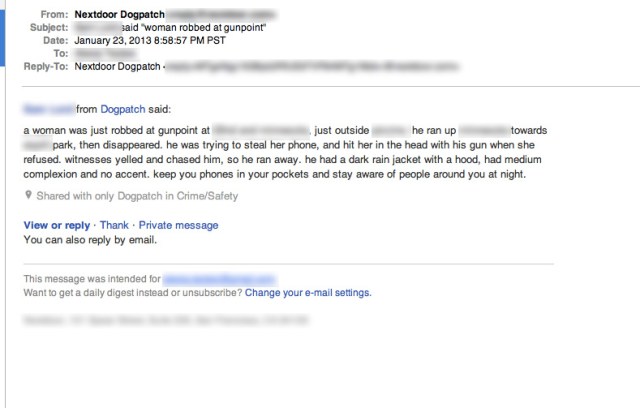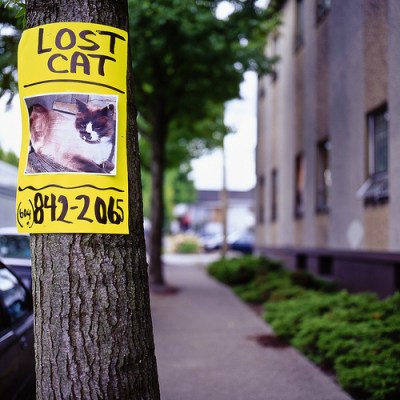After I had been running at night for more than a decade, a relatively under-the-radar startup called Nextdoor got me to start running during the day.
Almost nobody likes to exercise, and for many, overcoming the motivational hump of putting on your shoes and gym clothes can be trying on even the best of days. One evening late in January I had finally overcome this initial barrier to entry, and was just about to stop blogging to do my usual 30-minute nightly sprint when I got the email.
“Woman robbed at gunpoint in Dogpatch, San Francisco” the subject line screamed. Unlike many of the emails I constantly receive, this was highly relevant to me, especially because, upon further inspection, the robbery had happened one block from my house.

Until this email, I hadn’t given too much thought to Nextdoor , a service that I signed up for at the Allen & Co conference last summer, where co-founder Nirav Tolia had given a talk about the local social network.
The company started out as Fanbase in 2009, and was an attempt to create a user-generated content version of ESPN.
Founders Tolia and Sarah Leary decided to pivot around May of 2010, and spent the next four to five months testing out different ideas. Fanbase officially pivoted to Nextdoor in September of 2010, starting out its pilot in Lorelei, a neighborhood in Menlo Park. Now a Facebook for your neighborhood, about half the Fanbase funding ended up carrying over, and Tolia and Leary ended up raising an additional $40.2 million for the new Nextdoor product.
Initially enthusiastic, I had also invited my neighbors to use the platform, which had resulted in a de facto neighborhood support group (including the services of a pet psychic) when their adventurous cat Kiki went missing. I wrote a post about it for TechCrunch and then sort of forgot about it, rarely logging on to peruse the listings of free stuff and garage sales.
Well I was certainly giving the service some thought now: “What if I had been that woman who was robbed?””What if I had ventured out of my house just 15 minutes earlier?” I was still in my gym clothes, after so much effort, and feeling antsy from my day of work. Worse, I was now worried about a random stranger I had only heard about through the Internet, and I still needed a run badly.
A flash of insight led me to explore Nextdoor for answers, and I asked, in the comment thread on the same post, “I just saw this as I was about to go jogging. Do you guys think it’s still unsafe? NEED TO JOG.”
Almost instantaneously someone responded, “@Alexia — Lots of cops in the neighborhood right now. They are still walking the scene, looking for clothing or a disposed weapon.” Okay. Great.
After a few seconds of contemplation, and, being relatively brave, I decided the police presence diminished the likelihood that I would also be robbed by the same perpetrator looking for more victims. I stepped out my door and went on one of the scariest jogs I’ve ever done.
I haven’t jogged after sunset since.

A service on the Internet had changed my decade-long, and arguably unsafe, habit of jogging at night almost instantly. Online behavior had had an effect on offline behavior — again. But this time at a local level in a way that I personally had never experienced.
“It’s very cool to have that kind of user story,” Tolia and Leary said when I shared my experience, “because it’s different than ‘I shared my photo and I got 1,000 likes on it.’ In Maslow’s ‘Hierarchy of Needs’, where you live is very important. Your neighborhood is important not only because you can share a ladder, or borrow a cup of sugar, but also because you’ve got 100 to 1,000 eyes looking out for you.”
In an investment environment that has cooled on consumers, hot for enterprise and scrambling to understand the frontiers of hardware and even Bitcoin, it might be easy to miss the appeal of bringing those eyes online. Investors Bill Gurley and David Sze did not.
With Facebook, LinkedIn and Twitter (and Instagram and Snapchat) between their firms, Sze and Gurley know a thing or two about online social networks. And both recently plunked down another $20 million into this unlikely candidate that connects a group of people based on where they live.
“The magic is happening,” Sze says, confirming what I’m seeing in my Dogpatch Nextdoor as a widespread phenomenon taking place in communities as socioeconomically diverse as the lower 9th ward in New Orleans and suburban Denver. “People are trusting each other and want to help. There’s a sense of community being brought back. If there’s a cat lost in the neighborhood, all the cat people are out looking for the cat. I’m a dog person and I’m caring about the cat. ”
Sze refers to the individual connections made through the service, like the borrowed tiki torches or the found lost pets, as Nextdoor’s “aha” moment. “On LinkedIn, the ‘aha!’ was when someone needed a job and found a job through their network. Facebook’s ‘aha’ wasn’t one thing, but the core aspect of Facebook that allowed you a greater sense of the lives of people whom you knew in the past. That’s magic.”
Magic aside, Nextdoor is facing several challenges: namely social network fatigue, stickiness and competition with real life analogues. It’s tough having to grow as a service that has friction in place on purpose. Invites are spread through tricky, word-of-mouth mechanisms like postcards to neighbors. Unlike Facebook, the service is not tied to a given identity, but to a given location — you have to provide physical proof of your address. The service also involves a number of trust and safety buffers like preventing people who live at the last known addresses of registered sex offenders from joining.
Despite these challenges, Nextdoor has grown from 3,000 to 10,000 neighborhoods since July, hitting the 10K milestone just last week. A Nextdoor community doesn’t launch until it’s got 10 members committed, and the median community has around 750 households. While the founders wouldn’t give me exact DAUs or MAUs, one could do back-of-the-napkin math and assume there’s somewhere in the neighborhood of over 1 million households signed up for the platform. Over three-fourths of its members are active, either opening an email message, posting or visiting the site at least once a week, Tolia says.
A Nextdoor neighborhood is considered mature when it’s reached over 70 percent household penetration — Dogpatch, San Francisco, which has a lively enough community by my estimation (or this post wouldn’t be happening), has just reached 20 percent. That doesn’t come as a surprise, as the service maintains its stickiness through very liberal, and sometimes heavy-handed email alerts. Nextdoor started allowing users to post to adjacent neighborhoods two months ago in an effort to further bolster engagement.
The founders hope that the company’s “Instagram moment” will be 30K neighborhoods, or 20 percent of all neighborhoods in the U.S., though they also have their eye on European expansion within the next year. “Something [is] there, and starting to work,” said Gurley, “but it [hasn’t] become a broadly based phenomenon yet.”
“Investors get accustomed to the rocketship thing,” Sze says about the company’s slow growth slog, taking a entire first year to get to 176 neighborhoods. “Facebook was everyone’s darling, growing like a weed. LinkedIn, like Nextdoor, was slower. It’s easy to laud the growth curve of a Facebook style and miss the LinkedIn style. Investors say, ‘It’s not growing fast, it won’t scale,’ and end up missing out on LinkedIn.”
The opportunity is undoubtedly big (Tolia and Leary estimate it at $100 billion). Every vehicle used for local advertising — the Yellow Pages, radio, newspaper — is currently on the decline, yet nothing viable has emerged to take their place. Instead, the space is littered with countless failures, with Everyblock, Yardsellr, Neighborhood.com and Neighborland either stagnant or in the deadpool. And don’t get me started on Aol’s Patch.
The problem, as Sze says, is that many companies approach local from a top-down perspective, using the editorial model where people broadcast local news to the masses. What Nextdoor and fellow Benchmark company Yelp have gotten right is that they nurture a populist, bottom-up model, created by individuals on the platform who form a marketplace where value can be created.
“It’s hard to get there if you don’t start in the right direction,” Sze informs me, giving my boss Tim Armstrong this piece of advice on Aol’s money-losing Patch: “Keep your eye on Nextdoor because you may need to buy it — or at least partner with it.”
According to Gurley, the startup has already seen about a thousand inbound biz-dev requests, which it’s tracking in a spreadsheet for when it comes time to extract that value, asserting that the utility of the discussion on Nextdoor will likely result in a higher conversion rate for businesses than photosharing.
While the cofounders maintain that they’re focused on growth, they tell me that once monetization does get incorporated into Nextdoor, it will look more like Google Adwords than traditional display. The platform could appeal to anyone from startups like Angie’s List, GrubHub and Sittercity that depend on local distribution, to a neighborhood pancake house that would normally advertise in something like the Yellow Pages or a throwaway direct mailer.
Tolia brings up a startup called Homeadvisor, where aggregated local businesses like plumbers and contractors pay you to listen to their pitches as a litmus test. “That tells you how much demand there is. And we can go a step further than Homeadvisor — target only people who live in Dogpatch, for example. And there is a very strong emotional element that people want to support the businesses in their area.”
The age-old manifestation of a local community, which is represented in analog by the welcome wagon, the PTA, the Neighborhood Watch and even the pole where people could post fliers about their missing dogs and cats, has slowly eroded as we become more isolated by television and the Internet. The cup of sugar example may have struck you as a cliché. Who does that anymore, right? The trust is gone. And every time someone brings up this example, I get these visions of the sugar being poisoned.
Nextdoor is perhaps the first step in reversing this process. “Technology has done a great job of making us closer to things that aren’t in close proximity,” says Tolia. “It’s time technology did a better job of connecting us to things that are literally right outside our front door.”
Even when those things are a robbery. Especially then.
[Lost cat image via]
